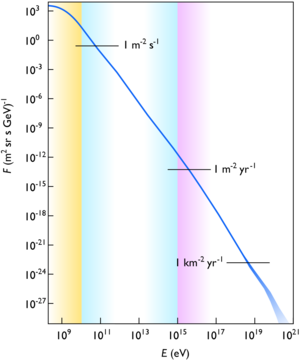Cosmic Rays
Cosmic rays are highly energetic particles which originate from extraterrestrial sources. A distinction between soft cosmic radiation stemming mainly from our sun and hard cosmic radiation produced outside our solar system can be made. When interacting with particles in the earth's atmosphere, primary cosmic rays can induce a high energy shower cascade yielding a multitude of newly produced particles.
Contents
Composition
Primary cosmic consists of about 90% of protons, about 9% of helium nuclei and 1% of heavier nuclei. The precise composition depends on the considered energy range. The energy distribution of primary cosmic particles, as shown o the plot on the right, has a most probable value of about 300 MeV (3 x 106 eV) and drops sharply for increasing energies. However, cosmic rays with energies up to 3 x 1020 eV (~ 50 J) have been observed.
As the energy of a primary cosmic particle hints at its origin, a classification in soft cosmic radiation with kinetic energies up to several hundred MeV and hard cosmic radiation is done. Soft cosmic radiation originates from the sun. The relatively low energy of these particles allows for a deflection due to the Earth's magnetic field. The deflected particles are steered towards the magnetic poles where they interact with the atmosphere which can be seen as polar lights.

